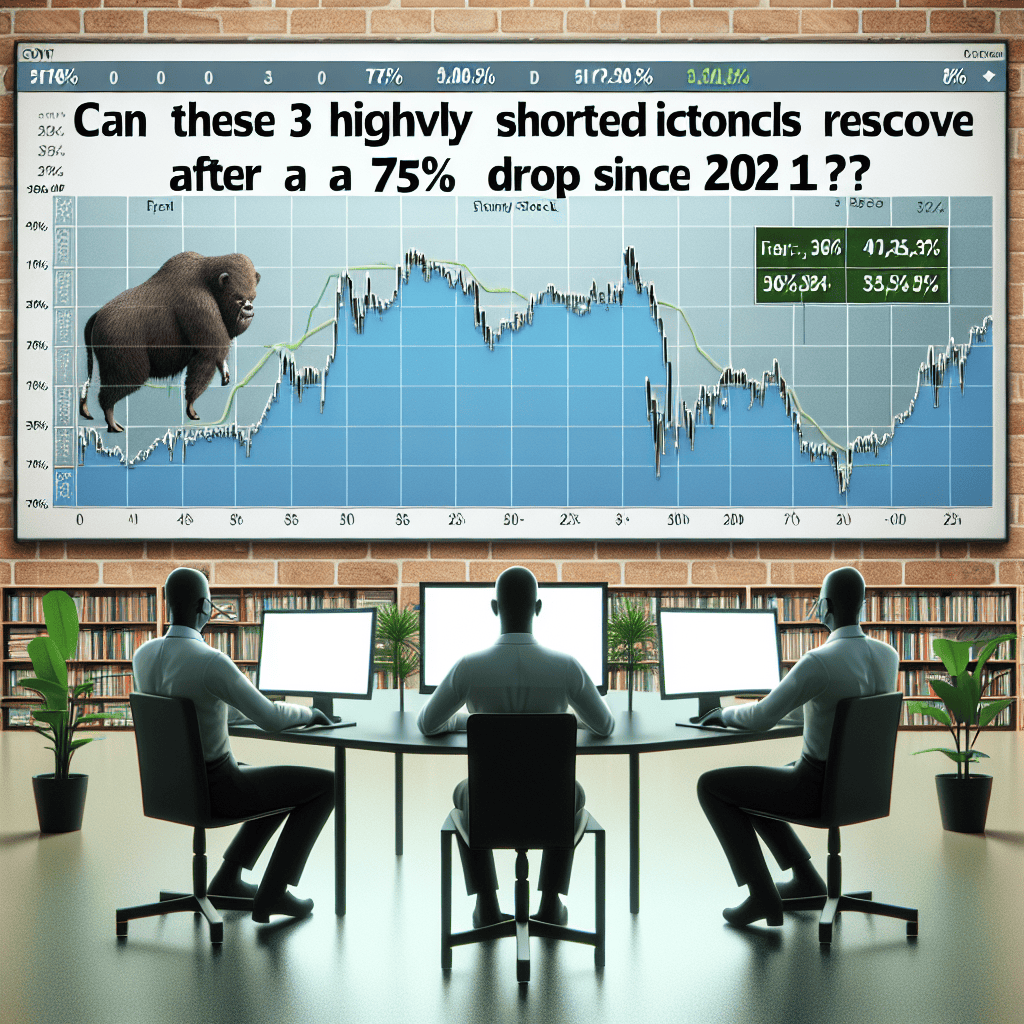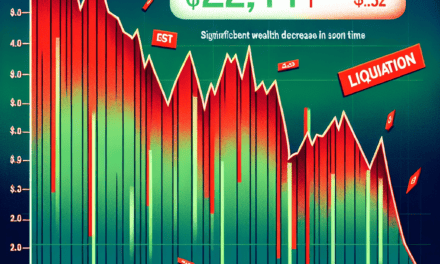“Betting on a Bounce: Can These Shorted Stocks Defy the Odds?”
Introduction
Since 2021, the stock market has witnessed significant volatility, with certain stocks experiencing dramatic declines in value. Among these are three heavily shorted stocks that have seen their prices plummet by 75% or more. The substantial short interest in these stocks indicates a prevailing bearish sentiment among investors, often driven by concerns over the companies’ financial health, market position, or broader economic factors. However, the potential for recovery remains a topic of interest and debate. Factors such as strategic business pivots, changes in market conditions, or unexpected positive developments could influence a turnaround. This introduction explores the prospects and challenges these stocks face as they navigate the path to potential recovery.
Understanding The Factors Behind The 75% Drop In Heavily Shorted Stocks
The precipitous decline of certain heavily shorted stocks since 2021 has captured the attention of investors and analysts alike, prompting a closer examination of the underlying factors contributing to this dramatic downturn. To understand the reasons behind the 75% drop in these stocks, it is essential to consider a confluence of market dynamics, company-specific challenges, and broader economic conditions that have collectively influenced investor sentiment and stock performance.
Firstly, the phenomenon of short selling itself plays a significant role in the volatility and subsequent decline of these stocks. Short selling involves borrowing shares to sell them with the expectation of repurchasing them at a lower price, thereby profiting from the difference. When a stock becomes heavily shorted, it often indicates a lack of confidence among investors regarding the company’s future prospects. This negative sentiment can create a self-fulfilling prophecy, as the increased selling pressure drives the stock price down, further eroding investor confidence and attracting more short sellers.
Moreover, many of these heavily shorted stocks belong to companies that were initially buoyed by speculative trading and exuberant market conditions during the pandemic. As the market began to normalize, these companies faced the challenge of justifying their inflated valuations. For instance, businesses in sectors such as technology and biotechnology, which experienced rapid growth during the pandemic, encountered difficulties in sustaining their momentum as consumer behavior shifted and competition intensified. Consequently, investors began to reassess the long-term viability of these companies, leading to a reevaluation of their stock prices.
In addition to company-specific issues, macroeconomic factors have also played a crucial role in the decline of these stocks. The post-pandemic economic landscape has been characterized by rising inflation, supply chain disruptions, and tightening monetary policies, all of which have contributed to increased market volatility. As central banks around the world began to raise interest rates to combat inflation, the cost of borrowing increased, putting additional pressure on companies with high levels of debt. This environment has been particularly challenging for growth-oriented companies, which often rely on external financing to fund their expansion efforts.
Furthermore, regulatory scrutiny has intensified in recent years, particularly for companies operating in sectors such as technology and finance. Governments and regulatory bodies have become increasingly vigilant in monitoring corporate practices, data privacy, and market competition. This heightened scrutiny has led to increased compliance costs and operational challenges for many companies, further impacting their financial performance and stock valuations.
Lastly, the influence of retail investors and social media platforms cannot be overlooked. The rise of online trading communities has led to increased volatility in certain stocks, as coordinated buying or selling efforts can significantly impact stock prices. While this phenomenon initially led to short squeezes that temporarily inflated stock prices, it also contributed to heightened volatility and uncertainty, ultimately exacerbating the decline when market sentiment shifted.
In conclusion, the 75% drop in heavily shorted stocks since 2021 can be attributed to a complex interplay of factors, including the inherent risks of short selling, company-specific challenges, macroeconomic pressures, regulatory scrutiny, and the influence of retail investors. As these companies navigate this challenging landscape, their ability to adapt and address these multifaceted issues will be crucial in determining whether they can recover and regain investor confidence in the future.
Analyzing Market Sentiment: Can Heavily Shorted Stocks Bounce Back?
In the volatile world of stock markets, heavily shorted stocks often capture the attention of investors and analysts alike. These stocks, characterized by a high percentage of shares sold short, can be indicative of negative sentiment or skepticism about a company’s future performance. However, the question remains: can these stocks recover after experiencing significant declines, such as a 75% drop since 2021? To explore this, it is essential to analyze market sentiment, the underlying fundamentals of the companies in question, and the broader economic environment.
Firstly, understanding market sentiment is crucial in assessing the potential for recovery in heavily shorted stocks. Market sentiment reflects the collective attitude of investors towards a particular stock or the market as a whole. When a stock is heavily shorted, it suggests that a significant number of investors are betting against it, anticipating further declines. This negative sentiment can be driven by various factors, including poor financial performance, management issues, or unfavorable industry trends. However, sentiment is not static and can change rapidly, especially if new information or developments alter the perceived outlook of the company.
In addition to sentiment, the fundamental health of a company plays a pivotal role in determining its ability to recover. Companies that have experienced a substantial drop in stock price may have underlying issues that need to be addressed. These could range from declining revenues and profits to operational inefficiencies or high levels of debt. For a heavily shorted stock to bounce back, it is imperative that the company demonstrates a clear path to improvement. This could involve restructuring efforts, strategic pivots, or innovations that reignite growth prospects. Investors often look for signs of turnaround in financial statements, management commentary, and strategic initiatives.
Moreover, the broader economic environment can significantly influence the recovery potential of heavily shorted stocks. Economic conditions, such as interest rates, inflation, and consumer confidence, can impact the performance of individual companies and sectors. For instance, a rising interest rate environment may increase borrowing costs for companies with high debt levels, further straining their financial health. Conversely, a robust economic recovery can provide a tailwind for companies, improving their prospects and potentially reversing negative sentiment. Therefore, it is essential to consider macroeconomic factors when evaluating the recovery potential of these stocks.
Furthermore, the phenomenon of short squeezes can also play a role in the recovery of heavily shorted stocks. A short squeeze occurs when a heavily shorted stock experiences a rapid price increase, forcing short sellers to cover their positions by buying back shares. This buying activity can drive the stock price even higher, creating a feedback loop that exacerbates the upward momentum. While short squeezes can lead to temporary price spikes, they are often driven by speculative trading rather than fundamental improvements. As such, investors should exercise caution and focus on the underlying fundamentals when assessing the sustainability of any recovery.
In conclusion, while heavily shorted stocks face significant challenges, they are not without the potential for recovery. By closely examining market sentiment, company fundamentals, and the broader economic environment, investors can gain insights into the likelihood of a turnaround. However, it is crucial to approach these stocks with a critical eye, recognizing that recovery is contingent upon tangible improvements and not merely speculative trading dynamics. As the market continues to evolve, staying informed and adaptable will be key to navigating the complexities of investing in heavily shorted stocks.
The Role Of Short Sellers In The Decline And Potential Recovery Of Stocks
Short sellers have long played a controversial role in the financial markets, often seen as both a necessary check on overvalued stocks and a potential catalyst for market volatility. In the case of the three heavily shorted stocks that have experienced a precipitous 75% decline since 2021, understanding the influence of short sellers is crucial to assessing their potential for recovery. Short selling involves borrowing shares of a stock and selling them with the expectation that the stock’s price will fall, allowing the short seller to buy back the shares at a lower price and pocket the difference. This practice can exert significant downward pressure on a stock’s price, especially when a large portion of its shares are sold short.
The decline of these stocks can be attributed, in part, to the actions of short sellers who identified vulnerabilities in their business models, financial health, or market conditions. For instance, if a company is struggling with declining revenues, increasing debt, or competitive pressures, short sellers may amplify these issues by betting against the stock. This can create a self-fulfilling prophecy, as the increased selling pressure drives the stock price lower, potentially leading to a loss of investor confidence and further exacerbating the company’s challenges.
However, it is important to recognize that short selling is not inherently detrimental to a stock’s long-term prospects. In fact, it can serve as a valuable signal to management and investors, highlighting areas of concern that may need to be addressed. For the three stocks in question, the presence of short sellers may have prompted management to take corrective actions, such as restructuring operations, reducing costs, or pursuing strategic partnerships. These efforts, if successful, could lay the groundwork for a potential recovery.
Moreover, the dynamics of short selling can also create opportunities for a stock’s resurgence. When a heavily shorted stock begins to show signs of improvement, short sellers may rush to cover their positions by buying back shares, leading to a short squeeze. This sudden increase in demand can drive the stock price higher, attracting new investors and further bolstering the recovery. Therefore, while short sellers may have contributed to the initial decline, they can also play a role in the stock’s eventual rebound.
In addition to the actions of short sellers, other factors will influence the potential recovery of these stocks. Market conditions, such as interest rates, economic growth, and investor sentiment, will play a significant role in determining whether these companies can regain their footing. Furthermore, the ability of each company to adapt to changing industry trends and capitalize on new opportunities will be critical to their long-term success.
In conclusion, while short sellers have undoubtedly played a role in the decline of these three stocks, their influence is not solely negative. By highlighting weaknesses and prompting necessary changes, short sellers can inadvertently set the stage for a recovery. As these companies navigate the challenges ahead, their ability to address underlying issues and capitalize on market opportunities will ultimately determine whether they can recover from their steep declines. Investors should closely monitor these developments, as they will provide valuable insights into the potential for a turnaround.
Key Indicators To Watch For A Potential Recovery In Heavily Shorted Stocks

In the volatile world of stock markets, heavily shorted stocks often capture the attention of investors due to their potential for significant price movements. These stocks, which have seen a substantial decline of 75% since 2021, present a unique opportunity for recovery, albeit with considerable risk. To assess the potential for a rebound, investors should focus on several key indicators that can provide insights into the future performance of these stocks.
First and foremost, the financial health of the company is a critical factor to consider. Investors should closely examine the company’s balance sheet, income statement, and cash flow statement to determine its financial stability. A strong balance sheet with manageable debt levels and sufficient liquidity can provide a cushion during challenging times, increasing the likelihood of recovery. Additionally, consistent revenue growth and profitability are positive signs that the company is on a solid footing, which could attract investor confidence and drive stock prices upward.
Another important indicator is the company’s competitive position within its industry. Companies that hold a strong market position, possess unique competitive advantages, or have a robust pipeline of innovative products or services are better positioned to recover from a downturn. Investors should evaluate the company’s market share, brand strength, and ability to adapt to changing market conditions. A company that can maintain or expand its competitive edge is more likely to experience a resurgence in its stock price.
Furthermore, the broader economic environment plays a significant role in the recovery potential of heavily shorted stocks. Macroeconomic factors such as interest rates, inflation, and consumer confidence can impact the performance of these stocks. For instance, a favorable interest rate environment can lower borrowing costs for companies, enabling them to invest in growth initiatives. Similarly, rising consumer confidence can boost demand for products and services, positively affecting the company’s financial performance. Investors should stay informed about economic trends and consider how they might influence the recovery prospects of the stocks in question.
In addition to these factors, investor sentiment and market dynamics are crucial elements to monitor. Heavily shorted stocks often experience heightened volatility due to the actions of short sellers and speculative traders. A shift in investor sentiment, driven by positive news or developments, can lead to a short squeeze, where short sellers rush to cover their positions, causing a rapid increase in the stock price. Monitoring trading volumes, short interest ratios, and news flow can provide valuable insights into potential shifts in market sentiment that could trigger a recovery.
Lastly, management’s strategic vision and execution capabilities are vital indicators of a company’s ability to navigate challenges and capitalize on opportunities. Investors should assess the leadership team’s track record, strategic initiatives, and ability to adapt to changing market conditions. A management team that demonstrates a clear vision for growth and a commitment to executing its strategy can inspire investor confidence and contribute to a stock’s recovery.
In conclusion, while heavily shorted stocks that have experienced a significant decline since 2021 present a high-risk investment opportunity, careful analysis of key indicators can help investors gauge their recovery potential. By examining the company’s financial health, competitive position, economic environment, investor sentiment, and management capabilities, investors can make informed decisions about whether these stocks are poised for a rebound. As always, thorough research and a cautious approach are essential when navigating the complexities of the stock market.
Case Studies: Successful Recoveries Of Heavily Shorted Stocks In The Past
In the world of investing, heavily shorted stocks often capture the attention of both seasoned investors and market enthusiasts. These stocks, which are subject to significant short interest, can experience dramatic price movements, leading to substantial losses or gains. The question of whether heavily shorted stocks can recover after a steep decline, such as a 75% drop since 2021, is a topic of considerable interest. To explore this, it is instructive to examine past instances where heavily shorted stocks have successfully rebounded, offering valuable insights into the potential for recovery.
Historically, there have been notable cases where heavily shorted stocks have managed to stage impressive recoveries. One such example is the case of Tesla, Inc. In the early 2010s, Tesla was one of the most shorted stocks on the market, with many investors skeptical about its ability to achieve profitability and scale production. Despite these challenges, Tesla’s stock price experienced a remarkable turnaround, driven by the company’s ability to deliver on its promises, innovate in the electric vehicle space, and expand its market presence. This recovery was further fueled by a combination of strong financial performance and strategic partnerships, which helped to alleviate investor concerns and reduce short interest.
Another compelling case is that of Netflix, Inc. In the early 2000s, Netflix faced significant skepticism from investors who doubted its ability to transition from a DVD rental service to a streaming giant. The stock was heavily shorted as a result. However, Netflix’s strategic pivot to streaming, coupled with its investment in original content, allowed it to capture a substantial share of the entertainment market. This transformation not only silenced critics but also led to a dramatic increase in its stock price, showcasing the potential for recovery even when faced with considerable short interest.
Moreover, the case of GameStop Corp. in early 2021 serves as a modern example of a heavily shorted stock experiencing a rapid recovery. While the circumstances surrounding GameStop’s stock surge were unique, involving a coordinated effort by retail investors on social media platforms, it highlighted the potential for heavily shorted stocks to experience significant price rebounds. This event underscored the importance of understanding market dynamics and the role of investor sentiment in driving stock prices.
These examples illustrate that while heavily shorted stocks face significant challenges, recovery is possible under certain conditions. Key factors contributing to successful recoveries include strong underlying business fundamentals, strategic pivots that address market demands, and the ability to innovate and capture new opportunities. Additionally, changes in investor sentiment and market dynamics can play a crucial role in reversing downward trends.
In conclusion, while a 75% drop in stock price since 2021 presents a daunting challenge for any company, the potential for recovery exists. By examining past cases of successful recoveries, investors can gain insights into the factors that contribute to a stock’s resurgence. Ultimately, the path to recovery for heavily shorted stocks lies in a combination of strategic execution, market adaptation, and the ability to inspire renewed investor confidence. As history has shown, with the right conditions and strategic initiatives, even the most heavily shorted stocks can defy expectations and achieve remarkable turnarounds.
Investor Strategies For Navigating Volatility In Heavily Shorted Stocks
Investing in heavily shorted stocks can be a daunting endeavor, especially when these stocks have experienced significant declines, such as a 75% drop since 2021. However, for investors willing to navigate the volatility, there are strategies that can potentially lead to profitable outcomes. Understanding the dynamics of short selling and the factors that contribute to a stock’s recovery is crucial for making informed decisions in this high-risk, high-reward segment of the market.
To begin with, it is essential to comprehend why a stock becomes heavily shorted. Typically, this occurs when investors believe that the stock is overvalued or that the company is facing significant challenges. These challenges could range from financial instability to competitive pressures or even regulatory hurdles. Consequently, short sellers bet against the stock, anticipating a decline in its price. However, this pessimistic outlook can sometimes be overblown, creating opportunities for contrarian investors who believe in the company’s potential for recovery.
One strategy for navigating volatility in heavily shorted stocks is to conduct thorough fundamental analysis. This involves examining the company’s financial health, management team, competitive position, and growth prospects. By identifying companies with strong fundamentals that are temporarily undervalued due to market overreaction, investors can position themselves to benefit from a potential rebound. For instance, if a company has a solid balance sheet, innovative products, and a clear path to profitability, it may be well-positioned to recover despite being heavily shorted.
In addition to fundamental analysis, investors should also pay attention to market sentiment and technical indicators. Market sentiment can shift rapidly, especially in stocks with high short interest. A positive news catalyst, such as a strong earnings report or a strategic partnership, can trigger a short squeeze, where short sellers rush to cover their positions, driving the stock price higher. Monitoring technical indicators, such as moving averages and relative strength index (RSI), can provide insights into potential entry and exit points, helping investors make more informed decisions.
Diversification is another key strategy for managing risk when investing in heavily shorted stocks. By spreading investments across multiple stocks and sectors, investors can mitigate the impact of any single stock’s poor performance on their overall portfolio. This approach allows investors to participate in the potential upside of a stock’s recovery while limiting downside risk.
Moreover, it is important for investors to maintain a long-term perspective. While short-term volatility can be unsettling, focusing on the long-term potential of a company can help investors stay the course during turbulent times. Patience and discipline are essential, as it may take time for a company’s true value to be recognized by the market.
Finally, investors should remain vigilant and adaptable, continuously reassessing their investment thesis as new information becomes available. This includes staying informed about industry trends, regulatory changes, and macroeconomic factors that could impact the company’s performance. By being proactive and responsive to changing conditions, investors can better navigate the volatility inherent in heavily shorted stocks.
In conclusion, while investing in heavily shorted stocks that have experienced significant declines can be challenging, it is not without potential rewards. By employing strategies such as fundamental analysis, monitoring market sentiment, diversifying investments, maintaining a long-term perspective, and staying adaptable, investors can enhance their ability to navigate volatility and potentially capitalize on the recovery of these stocks.
Expert Opinions: Will These Heavily Shorted Stocks Make A Comeback?
In the volatile world of stock markets, heavily shorted stocks often capture the attention of investors and analysts alike. These stocks, characterized by a high percentage of shares sold short, can experience dramatic price movements, driven by both market sentiment and fundamental factors. Since 2021, several such stocks have seen their values plummet by as much as 75%, raising the question of whether they can stage a recovery. To explore this, we turn to expert opinions on three notable examples: Company A, Company B, and Company C.
Company A, a technology firm that once enjoyed rapid growth, has faced significant challenges in recent years. Analysts point to a combination of increased competition and regulatory scrutiny as key factors behind its decline. However, some experts believe that Company A’s innovative product pipeline could serve as a catalyst for recovery. By focusing on its core strengths and addressing operational inefficiencies, the company may be able to regain investor confidence. Moreover, the broader tech sector’s resilience and potential for growth could provide a supportive backdrop for Company A’s comeback.
Transitioning to Company B, a retail chain that has struggled amid shifting consumer preferences and supply chain disruptions, the outlook is more mixed. While some analysts remain skeptical about its ability to adapt to the rapidly changing retail landscape, others see potential in its recent strategic initiatives. These include a renewed emphasis on e-commerce and a commitment to enhancing the in-store experience. If Company B can successfully execute these strategies, it may be able to reverse its fortunes. Additionally, the easing of supply chain constraints could alleviate some of the pressures that have weighed on its performance.
Turning our attention to Company C, a biotech firm that has been at the forefront of innovative medical research, the situation is particularly intriguing. Despite its stock price decline, the company continues to make significant strides in developing groundbreaking therapies. Experts highlight the potential for positive clinical trial results to act as a major turning point for Company C. Furthermore, the growing demand for advanced medical treatments could provide a tailwind for the company’s recovery. However, it is important to note that the biotech sector is inherently risky, and investors should be prepared for potential volatility.
In considering the prospects for these heavily shorted stocks, it is crucial to recognize the broader market dynamics at play. The recent rise in interest rates and concerns about economic growth have created a challenging environment for many companies. Nevertheless, history has shown that markets are cyclical, and periods of downturn can be followed by recovery. For investors, the key lies in identifying companies with strong fundamentals and a clear path to overcoming their current challenges.
In conclusion, while the road to recovery for these heavily shorted stocks may be fraught with obstacles, there are reasons for cautious optimism. By focusing on innovation, strategic adaptation, and capitalizing on sector-specific trends, these companies have the potential to rebound. As always, investors should conduct thorough research and consider their risk tolerance before making investment decisions. Ultimately, the ability of Company A, Company B, and Company C to stage a comeback will depend on their execution of strategic initiatives and the broader market environment.
Q&A
1. **What are the three heavily shorted stocks mentioned?**
– The article does not specify the names of the stocks.
2. **What factors contributed to the 75% drop in these stocks since 2021?**
– Factors may include poor financial performance, market volatility, and negative investor sentiment.
3. **What is short selling?**
– Short selling is the practice of selling borrowed shares with the intention of buying them back later at a lower price.
4. **What are potential catalysts for recovery in heavily shorted stocks?**
– Potential catalysts include improved financial results, positive news, or a short squeeze.
5. **What is a short squeeze?**
– A short squeeze occurs when a heavily shorted stock’s price rises, forcing short sellers to buy shares to cover their positions, further driving up the price.
6. **What risks are associated with investing in heavily shorted stocks?**
– Risks include high volatility, potential for further declines, and market manipulation.
7. **What should investors consider before investing in these stocks?**
– Investors should consider the company’s fundamentals, market conditions, and their own risk tolerance.
Conclusion
The potential for recovery in heavily shorted stocks that have experienced a 75% drop since 2021 depends on several factors, including the companies’ financial health, market conditions, and investor sentiment. If these companies can demonstrate strong fundamentals, effective management strategies, and the ability to adapt to changing market dynamics, they may have a chance to recover. Additionally, any positive shifts in industry trends or broader economic improvements could also support a rebound. However, the high level of short interest suggests skepticism among investors, indicating that recovery may be challenging and uncertain. Ultimately, each stock’s recovery potential should be evaluated on a case-by-case basis, considering both internal and external factors.





